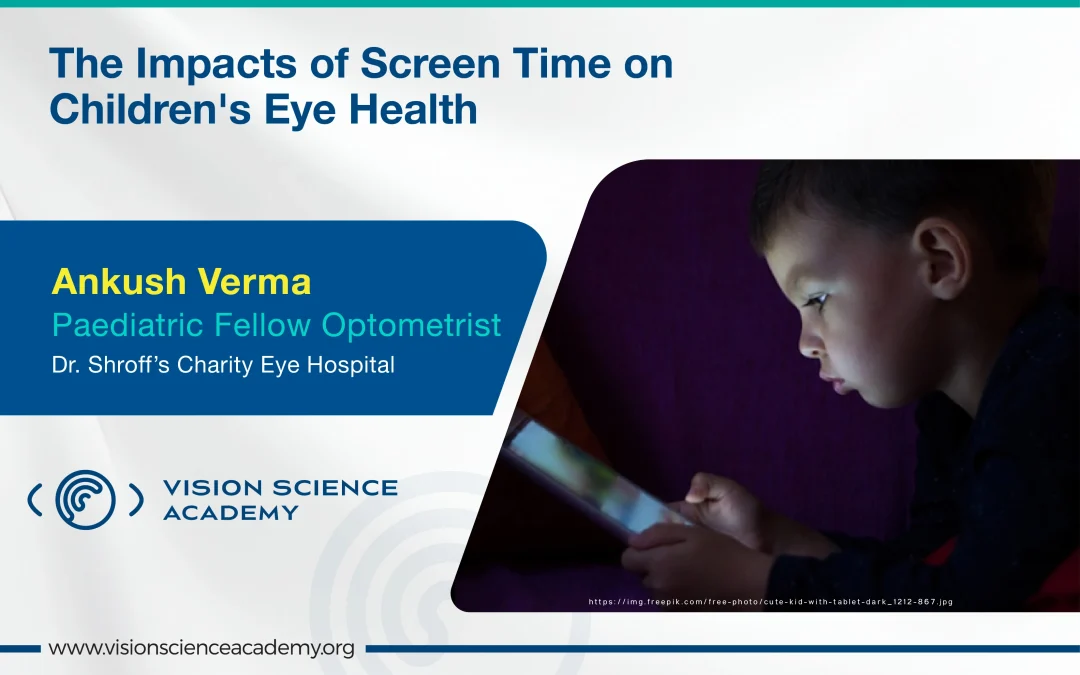Ankush Verma, B.Optom.
Paediatric Fellow Optometrist, Dr. Shroff’s Charity Eye Hospital, New Delhi, India
In today’s digital age, children spend increasing amounts of time in front of screens, whether for entertainment, virtual learning, or social interaction. (1) With screens becoming an integral part of daily life, there is growing concern about their impact on children’s eye health. (2) Research shows that children aged 5 to 16 in the UK spend an average of 6.3 hours a day on screens. (3) This issue has been exacerbated by the COVID-19 pandemic, which pushed students to rely more on digital devices for education, leading to a significant rise in screen time. (4) According to a 2022 report by Common Sense Media, children aged 8 to 12 spend an average of 4.44 hours daily on screens, while teenagers spend over 7 hours. (5)
Blue light exposure is also a concern, as children’s eyes absorb more blue light than adults’ eyes.(6) Reducing screen time and encouraging outdoor activities can help mitigate the risk of myopia.(6) To protect their eyes, children should take regular breaks following the 20-20-20 rule: every 20 minutes of screen time, take a 20-second break and look at something 20 feet away. (1)
Prolonged screen exposure can lead to digital eye strain or computer vision syndrome (CVS), causing symptoms like dry eyes, blurred vision, headaches, and neck pain. (8) Children’s developing visual systems make them particularly vulnerable to these effects. (3) Additionally, the blue light emitted by screens can disrupt sleep patterns, leading to further health complications. (7) Dry Eye Syndrome, characterised by insufficient tear production, is another condition exacerbated by excessive screen use, causing eye irritation and blurred vision. (1)
A notable impact of prolonged screen time is the increased prevalence of myopia, or near-sightedness. (2) Myopia has become increasingly common among children worldwide, with studies indicating a significant rise in cases over the past few decades. (3) A pivotal study published in the journal Ophthalmology in 2020 revealed that the prevalence of myopia in children has doubled over the past 50 years, with increased screen time being a substantial contributing factor. (2)
Myopia happens when kids spend too much time looking at screens and not enough time playing outside. When they look at screens up close for a long time, their eyes change shape and grow longer, leading to myopia. (2)
In conclusion, while screens offer significant benefits, their impact on children’s eye health cannot be ignored. (9)
While digital devices offer significant educational and entertainment benefits, their impact on children’s eye health cannot be overlooked. It is important to strike a balance between screen time and other activities, ensuring children’s eye health is protected, through awareness, regular breaks, outdoor activities, and proper eye care, parents and caregivers can help safeguard children’s vision in the digital age, encouraging regular breaks during screen time and advocating for outdoor play to ensure exposure to natural light. (7)
References:
- Kaur, K., Gurnani, B., Nayak, S., Deori, N., Kaur, S., Jethani, J., Singh, D., Agarkar, S., Hussaindeen, J. R., Sukhija, J., & Mishra, D. (2022). Digital Eye Strain- a comprehensive review. Ophthalmology and Therapy, 11(5), 1655–1680. https://doi.org/10.1007/s40123-022-00540-9
- Agarwal, D., Saxena, R., Gupta, V., Mani, K., Dhiman, R., Bhardawaj, A., & Vashist, P. (2020). Prevalence of myopia in Indian school children: Meta-analysis of last four decades. PLoS ONE, 15(10), e0240750. https://doi.org/10.1371/journal.pone.0240750
- Lanca, C., & Saw, S. (2020). The association between digital screen time and myopia: A systematic review. Ophthalmic and Physiological Optics, 40(2), 216–229. https://doi.org/10.1111/opo.12657
- Effect of screening time on children’s eyes. (2022). Clinical Pediatrics: Open Access. https://doi.org/10.35248/2572-0775.22.7.202
- Sheppard, A. L., & Wolffsohn, J. S. (2018). Digital eye strain: prevalence, measurement and amelioration. BMJ Open Ophthalmology, 3(1), e000146. https://doi.org/10.1136/bmjophth-2018-000146
- Hill, D., Ameenuddin, N., Chassiakos, Y. R., Cross, C., Hutchinson, J., Levine, A., Boyd, R., Mendelson, R., Moreno, M., & Swanson, W. S. (2016). Media and young minds. PEDIATRICS, 138(5). https://doi.org/10.1542/peds.2016-2591
- Huang, H., Chang, D. S., & Wu, P. (2015). The Association between Near Work Activities and Myopia in Children—A Systematic Review and Meta-Analysis. PLoS ONE, 10(10), e0140419. https://doi.org/10.1371/journal.pone.0140419
- Marshall, E. C., Meetz, R. E., & Harmon, L. L. (2010). Through our children’s eyes—The public health impact of the vision screening requirements for Indiana school children. Optometry, 81(2), 71–82. https://doi.org/10.1016/j.optm.2009.04.099
- Tonge, B. J. (1990). The impact of television on children and clinical practice. Australian & New Zealand Journal of Psychiatry, 24(4), 552–560. https://doi.org/10.3109/00048679009062912
- Monackey, H., & Monackey, H. (2017, August 2). Strategies to Help Children Use Digital Devices Safely | WakeMed Voices Blog.https://wakemedvoices.com/2017/01/digital-world-dangers/


Recent Comments